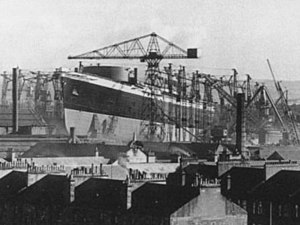SS Star of Krondor (1939)
 SS Star of Krondor' underway, 1943
| |
| History | |
|---|---|
| Name: | SS Star of Krondor |
| Namesake: | Krondor |
| Owner: | Maersk Lines Shipping Group |
| Operator: | Maersk Lines |
| Port of registry: | Template:Country data North Bardonia Krondor |
| Route: |
|
| Ordered: | 1939 |
| Builder: | Krondor General Shipyards, Krondor, North Bardonia |
| Cost: | ₪.5 million |
| Yard number: | 100 |
| Laid down: | September 19th, 1939 |
| Launched: | July 1941 |
| Christened: | March 12th, 1942 |
| Completed: | March 1942 |
| Maiden voyage: | November 16th, 1942 |
| Out of service: | July 14th 1955 |
| Fate: | Caught fire on July 12th |
| General characteristics | |
| Type: | Ocean liner |
| Tonnage: | 83,673 GRT |
| Displacement: | 83,000+ |
| Length: | 1,031 ft (314 m) |
| Beam: | 118 ft (36.0 m) |
| Height: | 233 ft (71.0 m) |
| Depth: | 18.4 ft (5.6 m) |
| Decks: | 14 |
| Installed power: | 12x Boilers |
| Propulsion: | 4x Wilson Steam Engines |
| Speed: | 28 knots (52 km/h; 32 mph) service speed |
| Capacity: | 3,618 (listed) |
| Crew: | 2,283 |
| Notes: | 1,235 |
The SS Star of Krondor was a North Bardonian ocean liner that caught fire and capsized off of the coast of Hooseria on July 12th, 1955, en route back home from the Port of Nicodemus (Spira) within Tussia via the Port of Vabasa in Hooseria to Krondor. At that time there were 1,823 Passengers on board with an additional 982 crew making a total of 2,805 people onboard, of these 1,011 died making it by far the deadliest maritime disaster in North Bardonian History, a title it maintains to this day.
The vessel was constructed by the Krondor General Shipyards and was one of the largest constructed at the time, ordered by Maersk Lines Shipping Group in 1939 construction was completed in 1942 and underwent its maiden voyage from Krondor to Kalidara on November 16th, 1942. The vessel would gain notoriety for its part in the North Bardonia-Hooserian-Tussia shipping lane, bringing tourist and businessmen through the three growing nations. Constructed during a low period for the global economy the ship would later become a symbol for economic growth and post war prosperity. On a routine journey back home, the ship would be lost taking half of her passengers and crew to a watery grave in part thanks to electrical failures, faults in her design and the incompetence and arrogance of her crew.
Much speculation has surrounded the sudden and disastrous loss of the vessel with numerous experts citing how the fire that would destroy the ship and the technical failings could only have been caused by sabotage. A government back investigation would be closed in 1957 with the event being listed as "accident", although many whistleblowers have cited the Augustines regime reformist attitudes and the 'Silent Coup' as a directly responsible for the disaster and the following covering up of the event. In the wake of the disaster Maersk Lines would begin to move away from traditional passenger ships and Maersk Lines herself would amalgamate her shipping company into Penitusian-Bardonian Lines.
Construction
The vessel was constructed by the Krondor General Shipyards and was one of the largest constructed at the time, ordered by Maersk Lines Shipping Group in 1939 construction was completed in 1942 and underwent its maiden voyage from Krondor to Kalidara on November 16th, 1942. The ship itself was third in the Star of North Bardonia class of vessels contructed from 1939 to 1943 and was one of six vessels: the others being the Star of North Bardonia (1941), the Star of Carthiada (1942), the Star of Krondor (1942), the Star of Lughansk (1943), the Star of Kharistan (1943), and the Star of Elijah (1943).
The Ship was also designed with state-of-the-art technology in mind which would priorities safety and speed for the ship with the innovations of the Great War taking a key role in the ships innovative design. Alongside numerous other developments the ship itself was designed by the world famous North Bardonian ship designer Ibrahim Asmal who designed the lavish interior alongside the exterior of the vessel. The ship alongside the expert designer also gained the advice and experience of Captain Wilfred Lesaur, a former Navy Captain and now an experience captain and an excellent host.
Alongside the excellent designers came the power of Krondor General Shipyards, the largest in North Bardonia, who had made hundreds of ships for Maersk and hundreds of ships for North Bardonia. The Ship would begin construction in September of 1939 and would be completed in 1942 with sea trials concluding in July and the finalisation of the ships interior in August allowing for the ship to take part on its maiden voyage in November of 1942.
Interestingly the ships destined route was already envision in its designers prior to its maiden voyage and even before construction began. The North Bardonian company seeing the Great War. The journey was that of Krondor to Kalidara then a cut across the Penitsuian towards Hooseria where it would stop before sailing onto Tussia before returning home. This route was sometimes referred to as the "Costal Crossing" as the ships that went along it rarely came across rough waters that were common in the ocean. The costal characteristic also made the cruise a comfortable and leisurely one that was all to calm with scenic views of some of the most beautiful city's and shores in the world.
